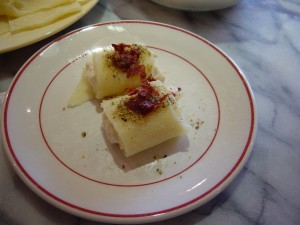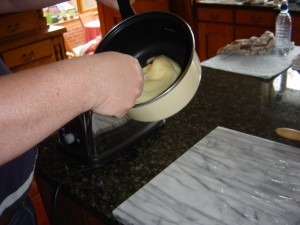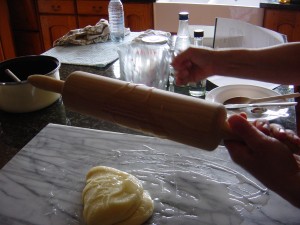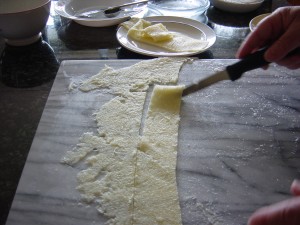This is basically white cheese usually the Lebanese Akkawi incorporated into semolina to create sheets, similar to a thin white cloth. The confectioners of Tripoli (Lebanon’s major northern city) excel in it. Halawet el Jebn has been their trade mark for centuries. I remember as a child that there was always excitement when someone brought us Halawet el Jebn from Tripoli. It can be tricky to make at home but not difficult when you get used to it. That is why I am suggesting a small quantity of ingredients to begin with, you can always double these later, it is worth practicing. The combination of cheese and semolina topped with Ashtah (clotted cream) and crushed pistachio gives this dessert a distinguished delightful taste.
Akkawi cheese is the ideal one for cooking, however, its high salt content means that it needs soaking in cold water, changing it several times to get rid of the saltiness. If Akkawi cheese is not available, use Mozzarella which is perfect because most of the brands have no or very little salt. The harder Mozzarella which is often used for pizza topping is ideal.
Serves 4
Ingredients
- 1 quantity of sugar syrup (See recipe).
- 250 g / 9 oz Akkawi or Mozzarella cheese
- 100 g / 4 oz fine semolina
- 2 tbsp of each orange flower and rose water
To serve
- 100 g / 4 oz Ashtah (clotted cream: See recipe)
- 2 tbsp crushed pistachio nuts
You also need a non-stick, medium sized pan with thick bottom and a rolling pin
Method
- If using Akkawi cheese, slice it thinly before you soak in cold water for a few hours, (changing the water several times). Mozzarella does not require soaking but you need to slice it thinly.
- Prepare the sugar syrup shortly before cooking the cheese. You need to have the syrup slightly warm, so it would be easier to handle. Measure 60 ml / 2¼ oz and keep aside for adding later to the cooking cheese.
- Using low to medium heat, melt the cheese completely, you need it runny and no lumps. You do not need to stir at this stage but be watchful. Meanwhile, moisten the working surface generously with 3 tbsp of the sugar syrup.
- Next, stir the reserved syrup into the melted cheese and mix well. Once this is achieved, gradually, add the semolina, orange flower and rose water. This is where you need to stir vigorously and continuously until you get a dough-like mixture that binds together and pulls away from the sides of the pan. This is very fast procedure that takes only a few minutes.
- Quickly and carefully (remember the dough is very hot), tip the dough into the working surface that you moistened with syrup earlier. Moisten a roller pin with sugar syrup and roll out the dough into a square (or rectangle) shape to a thickness of about 3-4 mm / 1/8 inch, (don’t worry if you don’t get it right because the toppings and especially the taste will prevent people from noticing any misshapes). Let it cool then cut into mini rectangles 5 cm x 3 cm / 2 inches x 1¼ inches. Arrange on a platter, try not to pile too many as they may stick (2 rectangle sheets are fine). If you are not eating immediately, cover and chill.
- There are 2 ways of serving this dessert. The first one: allow 2 sheets per person of Halawet el Jebn, put it on a plate, top it with Ashtah or clotted cream, sprinkle generously with crushed pistachio nuts and let people help themselves to drizzle the sugar syrup.
- The other way is to put about 1 tbsp of Ashtah or clotted cream in the middle of each rectangular sheet, roll it up so it looks like a roll, dust generously with the crushed pistachio nuts and serve passing the sugar syrup round.
NB. Ideally, it is better to top or fill Halawet el Jebn with Ashtah or clotted cream just before serving. Halawet el Jebn keeps up to 3 days if covered with clingfilm, chilled and left unfilled with Ashtah.





